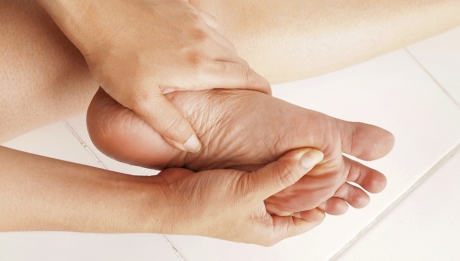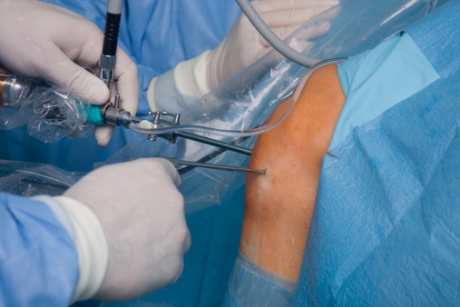Are you aware of how your feet affect your health? With warmer weather bringing increased outdoor activity, it is a good time to be more mindful of our feet and how they affect our overall health.
Certain foot problems may be an indication of a health issue. For example, ridged or pitted toenails can be a sign of eczema or psoriasis, an inflamed skin condition. Pale or blue feet may be a sign of circulatory problems. Numbness and tingling may be a sign of diabetes. Be aware of the various foot conditions below to stay healthy and keep the spring in your step.
Because the feet are at the foundation for all we do, mechanical problems can occur such as hammertoes, heel pain/spurs, painful metatarsals, flat feet, nerve entrapment, sprains, strains, tendinitis, and fractures. Foot pain can even arise from wearing wrong-fitting shoes or being overweight. If you are experiencing foot pain, contact a board-certified orthopaedist today for a consultation.
Foot trauma
Foot injuries can occur during normal daily activities, on the job, while exercising, and while participating in sports and other physical activities. Many injuries can develop from your feet not functioning properly, including shin splints, stress fractures, heel pain, runner’s knee, and other lower extremity problems.
The foot is made-up of 26 bones, 107 ligaments and 19 muscles. With so much complexity, many things can happen. If you have pain, tenderness, bruising or swelling that does not resolve with rest, it is best to have your foot evaluated and properly treated by an orthopedic doctor.
Bunions
If you have a bunion, you know it can be a painful enlargement at the joint of the big toe. The skin over the joint becomes swollen and is often quite tender. Bunions can be inherited as a family trait, can develop with no recognizable cause, or can be caused by shoes that fit poorly. An important part of treatment is wearing shoes that conform to the shape of the foot and do not cause pressure areas. This often alleviates the pain. In severe cases, bunions can be disabling. Several types of surgery are available that may relieve pain and improve the appearance of the foot. Surgery is usually done to relieve pain and is not meant for cosmetic purposes.
Heel pain
Heel pain is extremely common. It often begins without injury and is felt under the heel, usually while standing or walking. It is usually worst when arising out of bed. Inflammation of the connective tissue on the sole of the foot (plantar fascia) where it attaches to the heel bone is the most common cause of pain. It is often associated with a bony protrusion (heel spur) seen on X-ray studies.
Most cases will improve spontaneously. Heel and stretching, medication to reduce swelling of the soft tissues in your foot, and shoe inserts are quite helpful. If pain continues, steroid injections or walking casts are used. Only in the most troubling and prolonged cases is surgery recommended.
Corns and Calluses
Corns and calluses are caused by pressure on the skin of your foot. They may occur when bones of the foot press against the shoe or when two foot bones press together. Common sites for corns and calluses are on the big toe and the fifth toe. Calluses underneath the ends of the foot bones (metatarsals) are common. Soft corns can occur between the toes.
Treatment involves relieving the pressure on the skin, usually by modifying the shoe. Pads to relieve the bony pressure are helpful, but they must be positioned carefully. On occasion, surgery is necessary to remove a bony prominence that causes the corn or callus.
Hammertoes
Hammertoes are one of several types of toe deformities. Hammertoes have a permanent sideways bend in your middle toe joint. The resulting deformity can be aggravated by tight shoes and usually results in pain over the prominent bony areas on the top of the toe and at the end of the toe. A hard corn may develop over this prominence. Treatment usually involves a shoe to better accommodate your deformed toe. Shoe inserts or pads also may help. If, after trying these treatments, you are still having marked difficulty, surgical treatment to straighten the toe or remove the prominent area of bone may be necessary.
Plantar Warts
Plantar warts occur on the sole of the foot and look like calluses. They result from an infection by a specific virus. They are like warts elsewhere, but they grow inward. The wart cannot grow outward because of weight placed on it when you stand. You may experience severe pain when walking, and can have just one or many plantar warts. Plantar warts are extremely difficult to treat, but success has been achieved with repeated applications of salicylic acid (available over the counter) to soften the overlying callus and expose the virus. Other treatments include injection of the warts with medication, freezing the warts with liquid nitrogen and, very rarely, surgery.
You do not have to suffer with foot pain, which can limit activity in your daily life. Depending on the problem and its severity, many orthopedic problems can be treated without surgery, often with corrective insoles, physical therapy, and activity modifications. Surgery can be provided by your orthopaedist in case conservative management doesn’t work.
Your orthopaedist is a medical doctor with extensive training in the diagnosis and nonsurgical and surgical treatment of the musculoskeletal system, including bones, joints, ligaments, tendons, muscles, and nerves.
Recognizing foot problems is important to your health. Sometimes, if you leave problems untreated, other parts of the body such as the knees and lower back can even be affected. Pay attention to any changes in your feet and get prompt medical treatment if you are unsure about what these changes mean.




